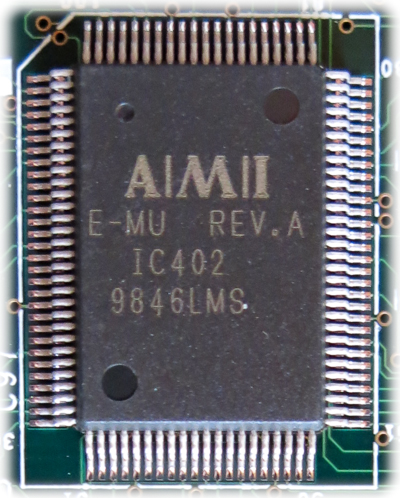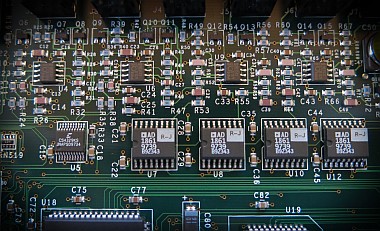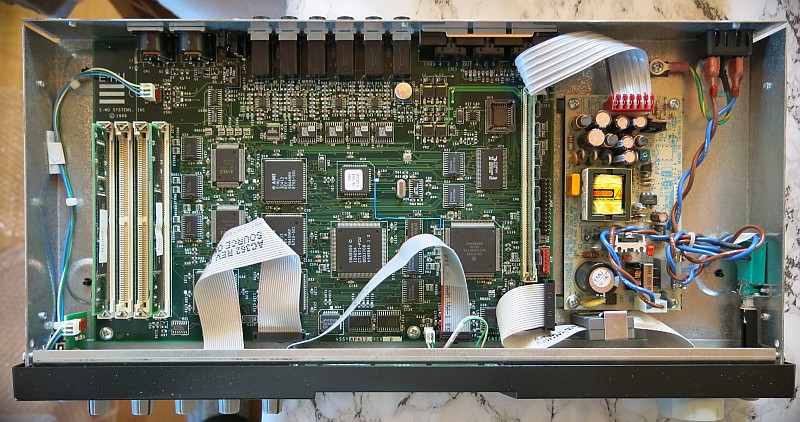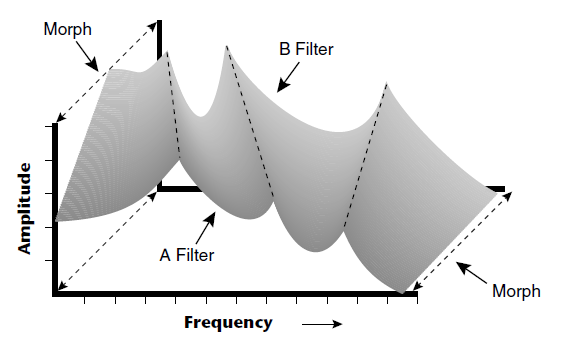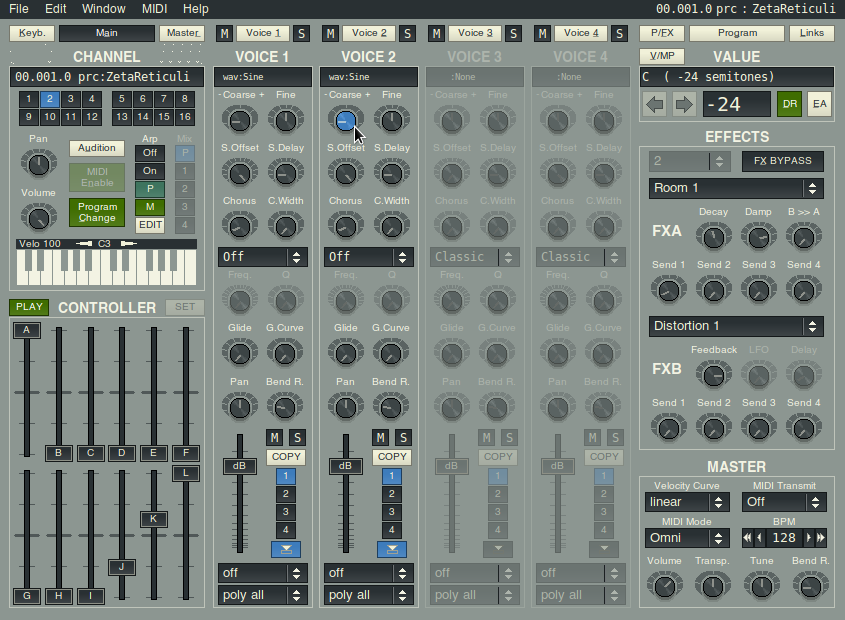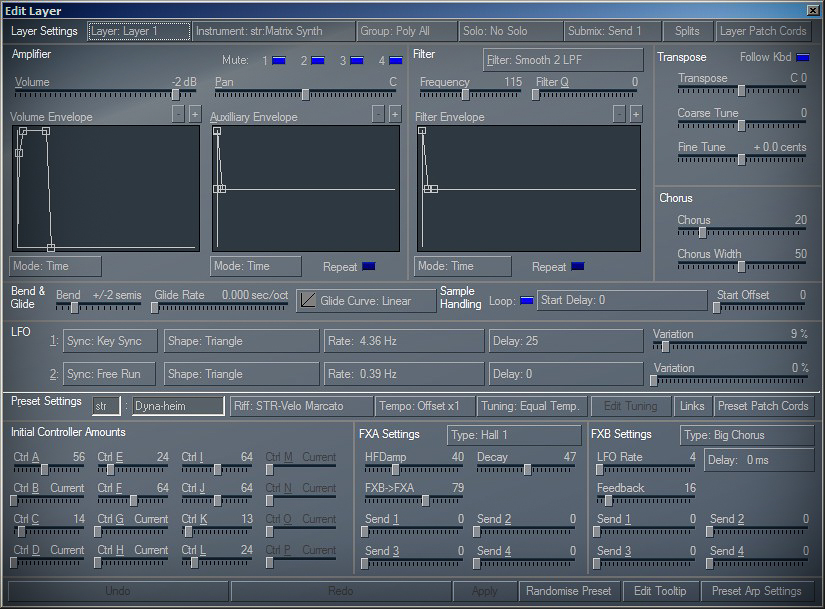Identifying E-MU ROM Patch Cords, as in modular synthesis Z-plane filter How many combinations Operation Manuals
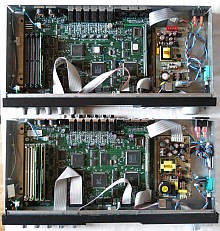 At least two different Proteus 2000 models where produced throughout its production run. Those I’ve encountered have very different main boards with many parts changed, including DAC used.
At least two different Proteus 2000 models where produced throughout its production run. Those I’ve encountered have very different main boards with many parts changed, including DAC used.
What s seems to be the oldest units, main board has E-MU logo and silk screen dated 1998 have different DAC's for MAIN's and SUB's outputs.
MAIN outs are from Cirrus Logic, CS4329 (Dual 20-bit Delta-Sigma, 128x oversampling, 106 dB dynamic range) and NE5532 op-amps
SUB1/SUB2 are fed from Analog Devices AD1861 (Mono 18-bit R-2R with up to 16x oversampling, 108 dB dynamic range) and NE5532 op-amps
Later units has Pactron labels inside and year 2000 on PCB silk screen. MAIN/SUB1/SUB2 on these came with
AKM AK4324 (Dual 1bit [24-bit delta] 128x oversampling, 105 dB dynamic range) and JRC4560 op-amps.
Proteus 2500 also make use of this AK4324 / JRC4560 combination.
According to datasheet's DAC’s on the older boards SUB out's have 2-3dB better headroom than the CS and AKM. How much practical impact this has on sound quality could be interesting to investigate. Personally being a sucker for R-2R DAC's in my hi-fi a proper blind test is needed to rule out a favorite.
S/PDIF out will bypass these MAIN DAC's if one want to color sound through favorite DAC, or go digital strait to DAW.
Later I’ll take the lid of an Extreme Lead 1 and Orbit 3 to compare with these 2000 boards. Please revisit.
Being the last hardware incarnation with DNA from the Emulator samplers one way of looking at the P2K series is to see it as an accumulation of Dave Rossum work in synthesis from early days of modular synths and being part of what today is considered to be historical highlights of Tom Oberheim, Dave Smits and Ron Dow (SSM chips) careers, towards his work designing affordable high-end end sampling technology evolving in Emulator/Emax/Proteus series over more than two decades. My understanding are that Dave Rossum wasn’t much involved in the actual design of the P2K series, but the machine in itself aren’t anything without its custom algorithms and G and H chips which are results of Dave’s creative work and knowledge.
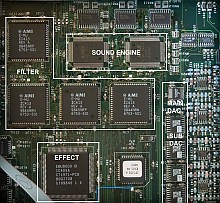 Under the hood P2K utilize all the custom DSP synthesizer chips from the Ultra series samplers released the same year.
Under the hood P2K utilize all the custom DSP synthesizer chips from the Ultra series samplers released the same year.
2x G-II Sound Engine Chip (E-MU IC402) 4x H 1.5 Digital Filter Chip (E-MU IC413) 1x E-MU8000 DSP Engine (E-MU IC405)
My initial love for the P2K started when I realized I had much of the power from my Emulator’s with zero loading time of standard E-MU sound libraries and no noise from hard drives or power fans.
G-chip
The G-chip is what made the Proteus its success from 1989 onwards. Although the Z-plane filters what’s first comes to mind when one hear the E-MU name mentioned the main reason for the great sound E-MU got its reputation for in the 90’ came from the synth engine stacked in this G-chip, responsible for pitch shifting samples. While most low cost vendors used speed manipulation at playback to shift pitch E-MU went to great length to develop custom chips and algorithms for more natural sounding sample playback.
G-II found in P2K have better resolution and fine-tuned algorithms for best possible reproducing of the original sample. In discussion about changes in Emulator IV series Dave Rossum mention this more accurate and detailed reproduction can in some instances be perceived as sounding slightly brighter than from older G-chips.
EMU8000 chip in P2K used for dual 24-bits effect engine do actually have a cost reduced G-chip pitch shift technology inside, bypassed in P2K though. This chip originally where developed for cheap Creative sound cards. The story as Dave Rossum tell it, EMU8000 found its way into E-MU products somewhat reluctant, but the team gave in as it sounded better than the 16-bit chip/algorithm (AD2105) E-MU used in earlier models, combined with very low cost.
P2K vs P1K
1000 series are cost down versions that for some models actually made sense. One can argue how many analog outputs and voices are needed to simulate a B-3 organ?
Initially there were differences between functionality in operating system for each model, like patterns and riffs. And typical for its time period major upgrades were not free. Now all models can run version 2.26 and have identical functionality expect for any hardware limitation and content on ROM modules (see table below).
It’s easy to spot the physical differences by looking at the back of the unit. Proteus 1000 series units are missing connectors for S/PDIF, SUB 1, SUB 2 and MIDI B (channel 17-32).
- P1K have 64 voices compared to P2K’s 128 voices.
- There are only two filter chips and a single sound engine chip.
- Two PCM/preset ROM can be mounted, including the factory card leaving only one slot for expansion.
- 4MB of DRAM vs 8MB in P2K, presets from all SIMMS modules are loaded into DRAM at boot time.
When ordering synth new from factory there where an option to order what normally where P1K units with P2K mainboard. Often referred to as Turbo upgrade. E-MU also released a few Turbo models with dedicated user manual like XL-1 Turbo, however content on ROM for this version seems identical to the P1K release.
Most keyboards from this generation are P1K, and Command Stations where build with P2K.
It’s not clear if the missing filter/engine chips have impact on sound design other than voice limitation. Any sound using chorus or 12th pole filters steal one voice for each layer it is activated on. If used on all 4 layers P1K still have 16 voice polyphony availably to morph through presets.
Firmware 2.26
Luckily it is super easy to upgrade over MIDI with E-Loader, if you have an old computer that is.
Use correct file for Proteus 1000 or 2000 series. Both are present in this zip bundle with E-Loader v.1.11.
Update January 2019 — Ray Bellis has made an online E-loader to simplify this process using modern computers.
Download Firmware 2.26
Older Release Notes
Changes since version 1.24
- All versions are now enabled for arps and beats (special upgrade OS no longer necessary)
- Now supports SIMMS that use two different ROM IDS (like PROM1)
- Supports sustain cord destinations for volume, filter, and aux envelopes
- Now supports the Vintage Pro model
- Fixed bug when the second SIMM of a two SIMM module (Virtuoso,Orbit3) was not installed
- Expanded clip range for preset transpose and links transpose to +- 127RELEASE NOTES: Proteus 2000 Version 2.26, November 01, 2002
P1K / P2K are acronyms to describe a family of more than twenty E-MU models
Proteus 2000 Vintage Pro Orbit 3 (Turbo) B-3 (Turbo) XL-1 (Turbo) Virtuoso 2000 Mo'Phatt Turbo Phatt Planet Earth (Turbo) Audity 2000 (v2) Proteus 1000 Vintage Keys PK-6 XK-6 MK-6 Proteus 2500 PX-7 XL-7 MP-7 Ensoniq Halo
Filter Presets
User manual rev B (paper version) only list seventeen 2th/4th/6th pole filters P2K originally where released with in 1999. Previous generation, the 32 voice Orbit 2, Carnaval etc. also had 17 filter presets.
Thirty three new 12th pole filters came with firmware version 1.10 the following year, giving a total of 50 filters as listed in the corresponding addendum. User manual rev E list all 50 filters from PDF page 113, printed page 105.
12th pole filter use two 6th pole filtered voices in series for each layer they are applied to, quickly cutting polyphony, - hardly a problem for today’s users.
While a 4th pole digital filter emulating analog LPF can be equivalent to a 24dB LPF, poles in digital filters are utilized very different than in the analog domain, so don't be fooled to visualize a +/-6dB slope for each pole.
Filter Types: 8x LPF Low-pass filter 2x HPF High-pass filter 3x BPF Band-pass filter 9x EQ+ EQ boost 2x EQ- EQ cut 8x VOW Vowel / formant 5x PHA Phaser 4x FLG Flanger 6x REZ Special resonance 1x WAH Wah-wah 1x DST Distortion 1x SFX Special Effect
Interestingly E-MU use the term filter presets about these filters. Meaning “to simplify use of the device user are not allowed to configure their own DSP filters?” Morpheus released 6 years earlier had 197 filter presets and Ultra Proteus crazy 288 filter presets, it’s clear E-MU must had a vision they needed to simplify the user interaction with the advanced feature sets of the Z-plane technology.
Z-plane filter Complete list of filters
Proteus 2000 series comes standard with 384, 512, 640 or 1024 ROM presets (depending on SIMM module) and 512 editable User preset locations. Presets are organized into banks of 128 presets each.
Update 2022
https://syntaur.com/ have now bought out all original E-mu parts from previus service provider.
How to identify E-MU SIMM modules for Proteus 1000/2000 series
Two types of memory storage are possible in P2K. ROM (read only memory) like all factory sound modules, and Flash that can be written to by user (with limitation). Either of these memory chips are soldered on a small printed circuit boards (PCB) called SIMM (single in-line memory module). Both memory types are seated in one of the four (two for P1K) common SIMM sockets on the main board.
Technically the term SIMM are more correct to use when referring to these PCB containing raw samples, presets and riff/beats as each SIMM contain multible ROM or Flash chips.
It is possible to test SIMM modules from the Diagnostic menu. To enter Diagnostics hold both arrow keys when powering up unit.
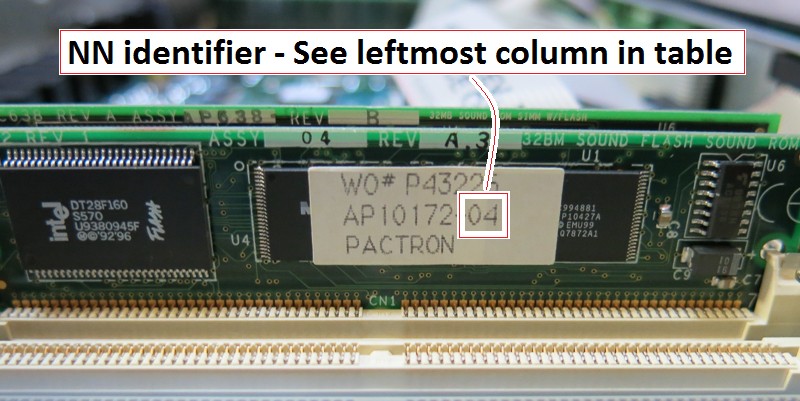
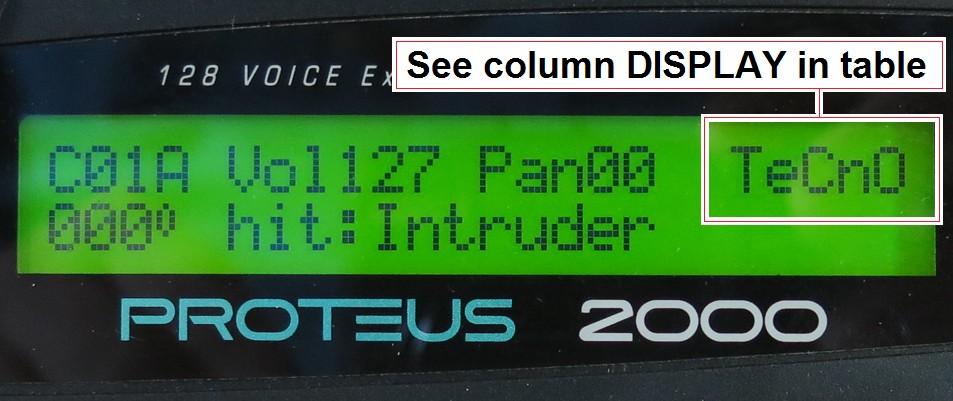
| NN | SIMM/friendly name | INSTRUMENT | xK* | LABEL | #BANKS | SAMPLES | DISPLAY | PART | Comment |
|---|---|---|---|---|---|---|---|---|---|
| 01 | composer | Proteus 2000 | 2K | COMPOSER | 8 / 386 Riff / DM | 1173 | CMPSR | Identical raw waveforms as P2500 and PROM1, different riffs and beats | |
| 02 | holy grail piano | - | - | GRAIL | 1 (16MB) | GRAIL | 9081 | ||
| 03 | protozoa | - | - | PROTOZOA | 4 (16MB) / DM | P/123 | 9082 | Proteus 1,2,3, ENSONIQ ZR-76, including William Coakley’s Perfect Piano | |
| 04 | construction yard | Orbit 3 | 2K | TECHNO SYNTH | 4 / 201 Riff / Arp / DM | 609 | TeCnO | 9084 | Rob Papen Techno Synth Construction Yard (TSCY), designed for dance, ambient and techno |
| 05 | definitive B3 | B-3 | 1K | 3 / 83 Riff | 140 | B-3 | 9083 | sound design by John Novello | |
| 06 | extreme lead v1 | Extreme Lead 1 | 1K | XL-1 | 4 / 153 Riff / DM | 1210 | XLEAD | 9089 | said to have all PCM from former ORBIT 1-2. Identical raw waveforms as XL-7 and XROM |
| 08 | orchestral v1 | Virtuoso 2000 | 2K | ORCH1 | 3 / 187 Riff | 81 | ORCH1 | 9085 | includes special presets for 4 speaker applications |
| 09 | orchestral v2 | Virtuoso 2000 | 2K | ORCH2 | 1 / DM | 240 | ORCH2 | 9086 | 4 speaker, percussion battery with over 20 instruments |
| 10 | siedlaczek | - | - | SIEDLACZEK | 2 / DM | AORCH | 9061 | The Peter Siedlaczek Advanced Orchestra Special Edition | |
| 11 | world expedition | Planet Earth | 1K | 4 / 308 Riff / DM | 807 | World | 9087 | traditional instruments from the four corners of the globe | |
| 12 | sounds of the ZR | - | - | 4 / DM | ZR | 9088 | Identical raw waveforms as QROM | ||
| 13 | pure phatt | Mo'Phatt | 1K | PHATT | 4 (bts) / 299 Riff / DM | 1099 | PHATT | 9062 | Identical raw waveforms as MP-7 and MROM |
| 14 | extreme lead | XL-7 Command Station | 2K | Xtreme Lead-1 | 4 / 127 Pattern / 182 Riff | 1210 | XL-7 | When new new filters came with firware upgrade. Identical raw waveforms as XL-1 and XROM | |
| 15 | pure phatt | MP-7 Command Station | 2K | 4 (kits) / 128 Patter / 822 Riff / DM | 1099 | MP-7 | Identical raw samples as PHATT and MROM. Designed for hip-hop | ||
| 16 | beat garden | Orbit 3 | 2K | 4 / 363 Riff / Arp | 389 | BEAT | 9063 | Rob Papen Beat Garden, combine techno and dance instruments with acoustic instruments and percussion | |
| 17 | pop collection | PK-6 Proteus Keys | 1K | 5 / 529 Riff | 1173 | PROM1 | 9140 | Identical raw waveforms as CMPSR and P2500 but has different riffs and beats. | |
| 18 | extreme lead v2 | XK-6 Xtreme Keys | 1K | XROM 1 | 5 / 331 Riff | 1210 | XROM | 9141 | Identical raw samples as XL-1 and XL-7 |
| 19 | pure phatt | MK-6 Mo’Phatt Keys | 1K | MROM 1 | 5 / 430 Riff | 1099 | MROM | Identical raw waveforms as MP-7 and PHATT. Riffs/Pattern differences | |
| 20 | composer | Proteus 2500 | 2K | 4 / 63 Pattern / 469 Riff | 1173 | P2500 | Identical raw waveforms as CMPSR and PROM1 but has different riffs and beats. Some presets altered to utelize these. | ||
| 21 | ensoniq project | - | - | QROM 2 | 4 | SONIQ | 9064 | ||
| 22 | sounds of the ZR | Ensoniq Halo | 1K | QROM | 5 | QROM | Identical raw waveforms as ZR | ||
| 23 | vintage collection | Vintage Pro | 2K | 4 / 260 Riff | 411 | VROM | 9065 | ||
| 24 | protean drums | PX-7 Command Station | 2K | 4 / 90 Patter / 186 Riff | 806 | DRUM | 9066 |
Table above derived from information found in this text file thoroughly documenting loads of technical information on the ROM SIMM modules in E-MU P1K/P2K series. Identifying E-MU ROM SIMMs for Proteus 2K Family
Some of the ROMs have identical PCM waveforms (raw instruments), like the [CMPSR, P2500, PROM1], [XL1, XL7, XROM] and [PHATT, MP7, MROM]. These often have variation in numbers of Riffs, Patterns and Presets. This might be more easy to spot from these pages
Overview of samples on a single page
Overviewv of riffs on single page
Overviewv of presets on single page
When SIMM modules are added to P1K/P2K banks of SIMM presets are also added according to table. But User space are still "limited" to 512 presets, 4 banks of 128 presets.
Update May 2022 - New SIMMs now being fabricated
Throughout the years several project have been worked on from different people and groups trying to create compatible SIMM's. Tim are the first to our knowledge that now can offer "clones" of old E-MU SIMM's. When this is written plan to later also offer SIMM's with custom content are announced on his site https://haxorhax.com/
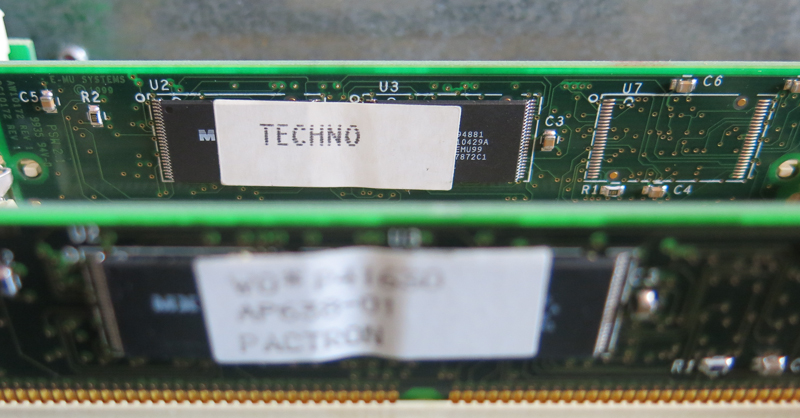
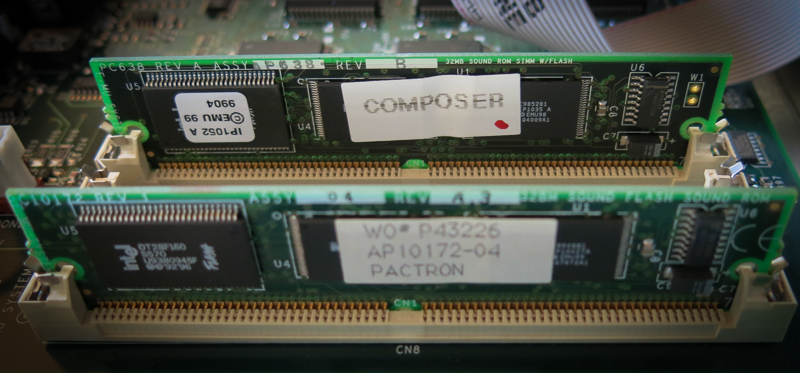
How to add custom samples
With E-MU Emulator IV Ultra series samplers one could blow empty flash ROM’s for use in P2K. The Sound Authoring Operation Manual show how to do this. Actually it's possible to copy flash modules inside P2K, but not from factory ROMs that are copy protected. Today we can buy an Ultra sampler for less money than these empty flash SIMM modules would cost 17 years ago. Sadly this outdated technology haven’t dropped much in price so cheapest way to use custom samples are to clear 3U space in your rack for an Emulator sampler of some kind.
Cool stuff
Patch Cords, as in modular synthesis
Each of the four sound layers can have 24 patch cords connecting internal modulation, real-time controls, synch and triggers to desired destinations. Each patch cord even has its own attenuator control that also can be modulatet or triggered from any sourche.
As with any good modular synth setup P2K come with several utility modules, hidden I the PACHCORD configurator from where one can use them as modulation or trigger sources after first patching something into them.
All the modulation inputs on P2K act as summing nodes, capable of multiple modulation sources from the PATCHCORD configurator.
Semitone intervals / Value:
M | 1 3 O | 2 6 D | 3 9 (approx.) U | 4 12 (approx.) L | 5 16 A | 6 19 T | 7 22 I | 8 25 O | 9 28 N | 10 31 (approx.) | 11 35 V | 12 38 A | 13 41 L | 14 44 U | 15 47 E | 16 50 | 17 53 (approx.) 3 | 18 57 ≠ | 19 60 1 | 20 63 | 21 66 S | 22 69 E | 23 72.5(approx.) M | 24 76 (approx.) I | 25 79 T | 26 82 O | 27 88 N | 28 91 E | 29 95 (approx.) | 30 98
Utility modules
Summing amp, multiple inputs with common amount knob out to destination, can also save cord slots
Switch, goes high when there is positive input
Lag Processor 0 and 1 (longer), lag behind the input
Absolute Value, invert negative values and output both pos & neg as positive
Diode, output only positive values and block negative
Flip-Flop, stay high until next negative to positive pulse
Quantizer, value on cord input controls the number of steps, value of the cord output controls the size of the steps
4x gain is an amplifier for low signal
Lag Inputs, summing amp with two outputs
Symbol used: + add +/- add & subtract < subtract
Modulation Sources:
Key (+, +/-) Velocity (+, +/-, <) RlsVel (Release Velocity) Gate Pressure PitchWhl (Pitch Wheel) ModWhl (Modulation Wheel) Pedal MIDI A MIDI B MIDI C MIDI D MIDI E MIDI F MIDI G MIDI H MIDI I MIDI J MIDI K MIDI L PLagOut (Preset Lag Out) PRampOut (Preset Ramp Out) FootSw1 (Foot Switch 1) FootSw2 (Foot Switch 2) FootSw3 (Foot Switch 3) FootnFF (Flip-Flop Foot Switch 1 -3) MIDI Volume (Controller 7) MIDI Pan (Controller 10) KeyGlide VolEnv +, +/-, < (Volume Envelope) FilEnv +, +/-, < (Filter Envelope) AuxEnv +, +/-, < (Auxiliary Envelope) LFO 1 (+, +/-) LFO 2 (+, +/-) White (White Noise) Pink (Pink Noise) XfdRand (Crossfade Random) KeyRand 1 & 2 (Key Random) Lag 0 sum (summing amp out) Lag 1 sum (summing amp out) Lag 0 & 1 (Lag Processor) Clk Divisors (Octal, Quad, Double Whole, Whole, Half, Qtr, 8th,16th) DC (DC Offset) Summing Amp Sum Switch Absolute Value Diode Flip-Flop Quantizer 4x Gain
Modulation Destinatons:
KeySust (Key Sustain) FinePtch (Fine Pitch) Pitch Glide ChrsAmt (Chorus Amount) ‘SStart (Sample Start) -note-on) SLoop (Sample Loop) SRetrig (Sample Retrigger) FiltFreq (Filter Frequency) ‘FiltRes (Filter Resonance -note-on) AmpVol (Amplifier Volume) AmpPan (Amplifier Pan) RTXfade (Real-time Crossfade) VEnvRts (Volume Envelope Rates -all) VEnvAtk (Volume Envelope Attack) VEnvDcy (Volume Envelope Decay) VEnvRls (Volume Envelope Release) FEnvRts (Filter Envelope Rates -all) FEnvAtk (Filter Envelope Attack) FEnvDcy (Filter Envelope Decay) FEnvRls (Filter Envelope Release) FEnvTrig (Filter Envelope Trigger) AEnvRts (Auxiliary Envelope Rates -all) AEnvAtk (Auxiliary Envelope Attack) AEnvDcy (Auxiliary Envelope Decay) AEnvRls (Auxiliary Envelope Release) AEnvTrig (Auxiliary Envelope Trigger) LFO 1 Rate LFO 2 Rate LFO 1 Trigger LFO 2 Trigger Lag Processor In 0 & 1 Sum (Summing Amp) Switch Abs (Absolute Value) Diode Quantize Flip-Flop Gain 4x Cord 1-24 Amount
Control Knobs

The front panel 4 by 3 Control Knob matrix can be thought of as front panel MIDI controllers because in the Proteus 2000, they are treated just as if they originated from an external MIDI device. They can be routet at will and data can also be send over MIDI port to external gear for performance recording or remote control.
17 different LFO Waveforms for interesting modulation
Remember all of these waveforms can be altered furder by patching modulation and clock sync to reset the LFO. There are a total of 8 LFO's for each four layer voice.
What is a Z-plane filter?
"A Z-plane filter is a filter which can change its function over time. In a Z-plane filter, we start with two complex filter types and interpolate between them using a single parameter. See the following diagram."
"Filters A and B represent two different complex filters or “frames.”
Changing a single parameter, the Morph, changes many complex filter parameters simultaneously. Following along the Morph axis you can see that the filter response smoothly interpolates between the two filters. This is the essence of the Z-plane filter. Through the use of interpolation, many complex parameters are condensed into one manageable entity.""Proteus 2000’s filter chips can implement 128 filters of 2nd to 6th order complexity or 64 filters of 12th order complexity."
Proteus 2000 Operation Manual rev E page 78/104
Is Proteus 2000 a true Z-plane synthesizer?
Sure it is. It has genuine Z-plane filters, even with better specifications than model's commonly thought of as Z-plane synthesis. But it will never sound as a Morpheus or UltraProteus when they utelize 2 by 4 filter frames. Operating system take a few different approaches when it comes to sound design.
Important to understand about Z-plane-plane filters used in E-MU hardware synth devices. One can easily be misled to believe morphing can be done between user selected filters. Truth is, all morphing is done inside a single ready made filter preset stored i ROM. To clearify, user only select a single predefined filter preset by name, that preset being constructed by 1,2 or up to 8 filters frames for Morpheus and UltraProteus.
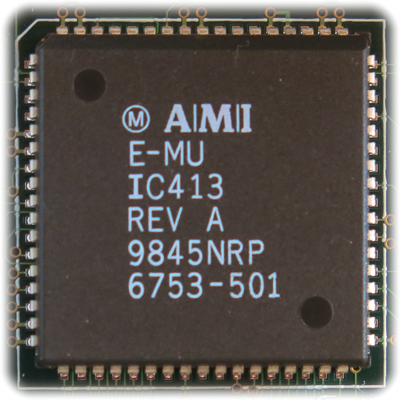 Architecture in newer Proteus modules let go of the advanced filter presets first seen in Morpheus, the Z-plane monster from 1993. E-MU found a different way of unleashing the power of the H filter chip after UltraProteus.
Architecture in newer Proteus modules let go of the advanced filter presets first seen in Morpheus, the Z-plane monster from 1993. E-MU found a different way of unleashing the power of the H filter chip after UltraProteus.
H filter chips are by hardware design capable of morphing two filter frames for each filter as explained above. This is true for all Proteus models including Morphius/UltraProteus. User manual will have you think of them as 2-dimensional.
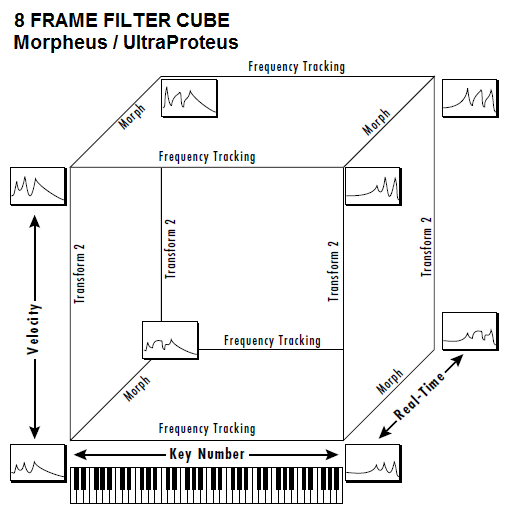 While P2K let user crossfade and modulate 4 layers (instruments) for evolving and crazy filtered soundscapes with 230300 unique 2-dimensional Z-plane filter preset combinations (50C4) the Morpheus can have up to four 2-dimensional predefined filters in one of its 197 filter presets. What set the Morpheus apart are that E-MU introduced a third control parameter to define a “position” in-between these filters. This third parameter can be modulated, but it becomes a fixed value from note-on while the 2-dimmensjonal part of the (up to) four Z-plane filters continuous do frame transition according modulation schemes, as it also does for the four layers in the P2K.
While P2K let user crossfade and modulate 4 layers (instruments) for evolving and crazy filtered soundscapes with 230300 unique 2-dimensional Z-plane filter preset combinations (50C4) the Morpheus can have up to four 2-dimensional predefined filters in one of its 197 filter presets. What set the Morpheus apart are that E-MU introduced a third control parameter to define a “position” in-between these filters. This third parameter can be modulated, but it becomes a fixed value from note-on while the 2-dimmensjonal part of the (up to) four Z-plane filters continuous do frame transition according modulation schemes, as it also does for the four layers in the P2K.
Each preset in Morphius and UltraProteus can do 2 layers but as the P2K it steal voices for higher order filters more quickly draining on its 32 voice capacity.
Andrew Simper (Cytomic) analyses of the Z-plane filter in 2016 revealed it as a Direct Form 1 Biquad Filter (second-order recursive(feedback) linear filter, containing two poles and two zeros) that can be chained to form multiple filter responses. When UltraProteus claims to have 288 filter presets, that’s more accurate than first assumed as it utilize only one filter technology but chain this filter differently in multiple presets.
Now three decades later with modern computer power and experience linear DF1 biquad filters are probably no longer the first chose when aiming for high quality analog filter emulation.
Some filters presets in early Z-plane devices are with varying success replicated in the effect section in later Proteus models. For monophonic sounds it's probably less obius to spot how they "cheated".
In Greek mythology Proteus is the prophetic old man of the sea and shepherd of the sea’s flocks (e.g., seals).
Proteus knew all things—past, present, and future—but disliked divulging what he knew. Those who wished to consult him had first to surprise and bind him during his noonday slumber. Even when caught he would try to escape by assuming all sorts of shapes. But if his captor held him fast, the god at last returned to his proper shape, gave the wished-for answer, and plunged into the sea.
The Editors of Encyclopædia Britannica
Would that imply we should read the manual before delving into the P2K?
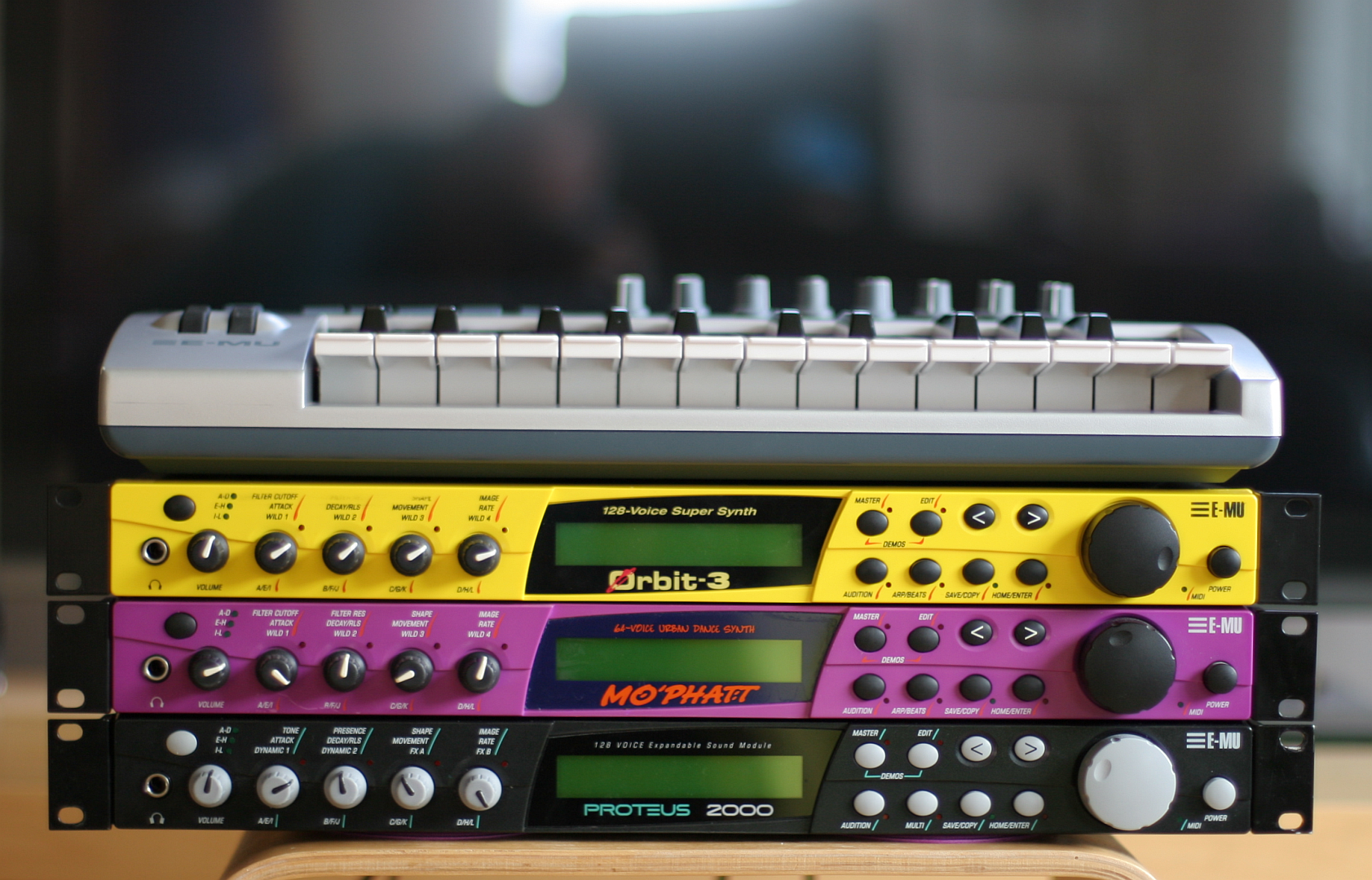
Arpeggiator
- Arpeggiator and/or Riff (BEATS) note data can be sent to the MIDI out port, even Merged with notes played on keyboard on MIDI input port- Arpeggiator and Riffs can respond to MIDI Song Start
- Ability to play different arpeggiators on up to 16 MIDI channels
- Arpeggiator Note On can be quantized, Pre Delayed, Duration (lenght of pattern), Resycled with optional Post Delay, and Latched (press key again to stop)
- 100 user patterns, each pattern can be up to 32 steps in length
Tip! - Digital modulation input
In addition to realtime controls like keys, wheels and foot switches each layer have 12 MIDI inputs, MIDI A-L that can be patched to any destination. Patched through helper modules in the PATCHCORD trigger can be created. A simple Arduino developer board could sample voltages from a modular synth or analog drum machine and convert to MIDI messages for integration with P2K's PATCHCORD.Chorus
Enabling Chorus in Layer Parameter work by duplication the layer using yet another voices to create the detuned chorus layer. In contrast to how the effect section will sample a copy and alter tuning on the sample activating it on the layer will make a true duplicate of the sound using the synth engine. Used to be a popular trick to fatten sounds on the IV sampler in its heydays.
Controls are Chorus detune (off/1-100%), and Width is the stereo spread (0-100%).
Filters

| Name | Poles | Type | Comment |
|---|---|---|---|
| Smooth | 02 | LPF | Typical OB type low-pass filter with a shallow 12 dB/octave slope. |
| Classic | 04 | LPF | 4-pole low-pass filter, the standard filter on classic analog synths. 24 dB/octave rolloff. |
| Steeper | 06 | LPF | 6-pole low-pass filter which has a steeper slope than a 4-pole low-pass filter. 36 dB/octave rolloff! |
| MegaSweepz | 12 | LPF | “Loud” LPF with a hard Q. Tweeters beware! |
| EarlyRizer | 12 | LPF | Classic analog sweeping with hot Q and Lo-end. |
| Millennium | 12 | LPF | Aggressive low-pass filter. Q gives you a variety of spiky tonal peaks. |
| KlubKlassik | 12 | LPF | Responsive low-pass filter sweep with a wide spectrum of Q sounds |
| BassBox-303 | 12 | LPF | Pumped up lows with TB-like squelchy Q factor. |
| Shallow | 02 | HPF | 2-pole high-pass filter. 12 dB/octave slope. |
| Deeper | 04 | HPF | Classic 4-pole high-pass filter. Cutoff sweep progressively cuts 4th Order High-pass. |
| Band-pass1 | 02 | BPF | Band-pass filter with 6 dB/octave rolloff on either side of the passband and Q control. |
| Band-pass2 | 04 | BPF | Band-pass filter with 12 dB/octave rolloff on either side of the passband and Q control. |
| ContraBand | 06 | BPF | A novel band-pass filter where the frequency peaks and dips midway in the frequency range. |
| Swept1>1oct | 06 | EQ+ | Parametric filter with 24 dB of boost or cut and a one octave bandwidth. |
| Swept2>1oct | 06 | EQ+ | Parametric filter with 24 dB of boost or cut. The bandwidth of the filter is two octaves wide at the low end of the audio spectrum, gradually changing to one octave wide at the upper end of the spectrum. |
| Swept3>1oct | 06 | EQ+ | Parametric filter with 24 dB of boost or cut. The bandwidth of the filter is three octaves wide at the low end of the audio spectrum, gradually changing to one octave wide at the upper end of the spectrum. |
| DJAlkaline | 12 | EQ+ | Band accentuating filter, Q shifts “ring” frequency. |
| AceOfBass | 12 | EQ+ | Bass-boost to bass-cut morph |
| TB-OrNot-TB | 12 | EQ+ | Great Bassline “Processor.” |
| BolandBass | 12 | EQ+ | Constant bass boost with mid-tone Q control. |
| BassTracer | 12 | EQ+ | Low Q boosts bass. Try sawtooth or square waveform with Q set to 115. |
| RogueHertz | 12 | EQ+ | Bass with mid-range boost and smooth Q. Sweep cutoff with Q at 127. |
| RazorBlades | 12 | EQ- | Cuts a series of frequency bands. Q selects different bands. |
| RadioCraze | 12 | EQ- | Band limited for a cheap radio-like EQ |
| AahAyEeh | 06 | VOW | Vowel formant filter which sweeps from “Ah” sound, through “Ay” sound to “Ee” sound at maximum frequency setting. Q varies the apparent size of the mouth cavity. |
| Ooh-To-Aah | 06 | VOW | Vowel formant filter which sweeps from “Oo” sound, through “Oh” sound to “Ah” sound at maximum frequency setting. Q varies the apparent size of mouth cavity. |
| MultiQVox | 12 | VOW | Multi-Formant, Map Q To velocity. |
| Ooh-To-Eee | 12 | VOW | Oooh to Eeee formant morph. |
| TalkingHedz | 12 | VOW | “Oui” morphing filter. Q adds peaks. |
| Eeh-To-Aah | 12 | VOW | “E” to “Ah” formant movement. Q accentuates “peakiness.” |
| UbuOrator | 12 | VOW | Aah-Uuh vowel with no Q. Raise Q for throaty vocals. |
| DeepBouche | 12 | VOW | French vowels! “Ou-Est” vowel at low Q. |
| PhazeShift1 | 06 | PHA | Recreates a comb filter effect typical of phase shifters. Frequency moves position of notches. Q varies the depth of the notches. |
| PhazeShift2 | 06 | PHA | Comb filter with slightly different notch frequency moving the frequency of notches. Q varies the depth of the notches. |
| FreakShifta | 12 | PHA | Phasey movement. Try major 6 interval and maximum Q. |
| CruzPusher | 12 | PHA | Accentuates harmonics at high Q. Try with a sawtooth LFO. |
| FlangerLite | 06 | FLG | Contains three notches. Frequency moves frequency and spacing of notches. Q increases flanging depth. |
| AngelzHairz | 12 | FLG | Smooth sweep flanger. Good with vox waves. eg. I094, Q =60 |
| DreamWeava | 12 | FLG | Directional Flanger. Poles shift down at low Q and up at high Q. |
| MeatyGizmo | 12 | REZ | Filter inverts at mid-Q. |
| DeadRinger | 12 | REZ | Permanent “Ringy” Q response. Many Q variations. |
| ZoomPeaks | 12 | REZ | High resonance nasal filter. |
| AcidRavage | 12 | REZ | Great analog Q response. Wide tonal range. Try with a sawtooth LFO. |
| BassOMatic | 12 | REZ | Low boost for basslines. Q goes to distortion at the maximum level. |
| LucifersQ | 12 | REZ | Violent mid Q filter! Take care with Q values 40-90. |
| ToothComb | 12 | REZ | Highly resonant harmonic peaks shift in unison. Try mid Q. |
| EarBender | 12 | WAH | Midway between wah & vowel. Strong mid-boost. Nasty at high Q settings. |
| FuzziFace | 12 | DST | Nasty clipped distortion. Q functions as mid-frequency tone control. |
| BlissBatz | 06 | SFX | Bat phaser from the Emulator 4. |
| KlangKling | 12 | SFX | Ringing Flange filter. Q “tunes” the ring frequency. |
Envelopes
Of the three envelopes available only DCA (volume envelope) are hard wired. The filter and auxiliary envelopes are manually patched by user. Attack, decay and release can all be modulated.
All three envelopes can be either time based from 1 ms to 160 seconds, or locked to master tempo where user select note length for each step in the envelope.
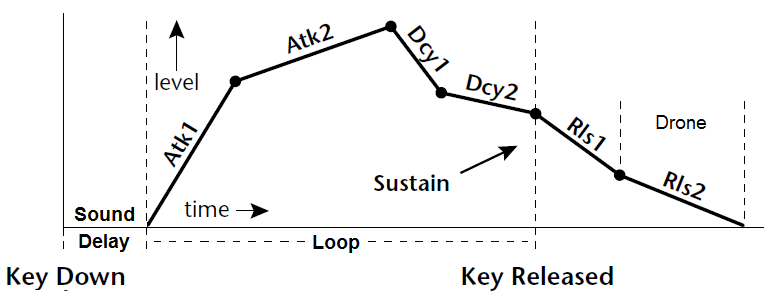
Any envelope step set to 0 (zero) are ignored. Envelopes can be looped between steps as shown above. If Release 2 are set to a long decay time it will drone until all voices are used.
From sound menu one can delay start of the layer (instrument). Turning CW select values from time domain, turning CCW select note length.
How many combinations?
If your ever wondered how many possible combinations there are with a given synth configuration there are several online Combinations Calculator (nCr) to help out.
Let's say you're curios how many unique patch combinations you can create with P2K's 64 modulation sources and 24 patch cords. This calculation are typical representet as 64C24 combinations = n! / r! (n - r)! return 250649105469666120 combinations. Actually the theoretically number are even higher if utilities modules are also patched in. Number of practical patch configuration are of course more limited.
This example 50C4 show number of unique filter preset combinations that can be done with a four layer preset and fifty filter presets. Feel free to try out a few other combinations. What about 8 voices, all with unique filter combination 50C8.
Mathisfun have a nCr calculator that even create lists for you if you like to document settings tested.
Operation Manuals
E-MU_Proteus-2000_OpMan_revE.pdf
E-MU_Virtuoso2K_OpMan_revB.pdf
Related resources
Tim's licensed SIMM clones https://haxorhax.com/
Ray Bellis made it possible to update firmware using your web browser http://www.emu.tools
Buy new P2K compatible SIMM's https://haxorhax.com/
Very well organised E-MU archive https://www.emumania.net/
Not complete but very well organised E-MU archive http://www.e-univercity.com/SynthGearDocs/
E-MU official product history http://www.creative.com/emu/company/history/timeline/
Original E-MU sounds legally licensed from Creative http://www.digitalsoundfactory.com/
Prodatum is a cross-platform patch editor http://prodatum.sourceforge.net/
Page last updated: June 06 2022 11:35:19.
Comments
Your comment are welcome
christ 2025-04-27 19:13:54 thanks, very useful article .
Aj Holden 2024-04-29 06:30:04 Hi there Hans, I wish to express my gratitude to you, for sharing this detailed information. You have created a very valuable resource. Thank you, and best wishes ! Austin
Pedro 2023-06-23 12:16:26 I have the following message on my proteus 2000: "Err: G20 chip U17 failed". Will it be fixed with the new firmware? Can anybody help me? Thanks
Guy 2023-05-28 23:09:12 Is there any chance that these SIMM clones could work in a Morpheus/UltraProteus? (Looking inside those machines, there is 1 SIMM slot - was this intended for ROM samples?) If not: would it be possible to make a SIMM which is compatible with those machines? (As in, are the specs available?) Would you have any interest in doing so (I would be very keen to collaborate on such a project :) ) Thanks!
Ray Bellis 2022-12-12 22:39:53 @AlexWright - check *very* closely for anything affecting the SIMM socket that the CPU RAM sits in. A friend of mine had almost exactly this fault last week and found two pins shorted in the socket.
Alex Wright 2022-11-04 15:34:17 My E-MU Proteus 2000 Was working fine up till a few days ago when it started showing this error message when I switched again which I tried another memory Rom but it is still the same have listed Error Message below Err: [ ] bit stuck high D16 D0 Continue? Does anyone know what the problem is please
Matt 2022-07-15 17:01:14 Does anybody know anything about flashing the boot loader on these units? For example, all the P1K motherboards are the same apart form the boot up animations on the LCD. It would be nice to be able to change the boot up screen when swapping out boards to repair units etc or to use a P2k board to make a 'Turbo' version of MoPhatt or Xtreme Lead! :)
Ben Voiles 2020-11-13 18:09:17 I have several EMU modules, I just got the B3. I am very pleased with it, but is there any advantage to buying an empty 2000 and putting the B3 chip in it? I see them all the time on EBAY. Seems like many people take the chips out since the chips seem to sell for more than entire units. Thanks, Ben
Daniel Forró 2020-09-11 08:59:50 "Virtuoso 2000" sold in Japan has a name "Proteus Orchestra".
Hans 2020-08-19 20:54:43 Thanks toobias. Surely will appreciate photos, please use contact info under About menu.
toobias 2020-08-19 16:15:41 Hi all. Great site!!! Thanks. Just for completeness - theres another Proteus 2000 version with a slight different mainboard, with TSOP56 flash ROM & JRC4562 ampops (DACs are the same AK4324). ps: can send photo if you guys want :) cheers
Gaston 2020-05-11 00:23:58 Hi everyone! Does anybody have schematics or service manual for this line? I have an XL1 that wont boot (led screen on, all lcd segments on and nothing more). Thanks.
Pat 2019-10-30 11:20:56 Are there two versions of the Techno Synth Construction yard ? As the patch shown for banks 2 and 3 above NN Line 04 are completely different from those in the manual pdf I downloaded from above. The maual has an error where bank 01 is listed twice but the whole of 02 and 03 are basically prc. The ROM have just purchased is as per the manual and of course I was expecting to find the other listed banks...
Hans 2019-08-21 18:23:49 To my knowledge it's not possible to dump firmware from p2k. If you have access to a modern computer with midi Ray Bellis online firmware update tool at emu.tools are the easiest way to do it.
monte lee 2019-08-21 15:50:42 I have many emu 2000 modules some have o.s. ver 2.26 and some do not. I do not have access to older computers(live in the country) is there any way to download upgrade a p2k from another p2k?
John Ellerington 2019-01-29 00:39:24 Have discovered that some ORCH1 presets require samples from ORCH2 and vice versa, so these ROMs need to be installed as a pair of you want all the presets to work. If you only install ORCH1, about half the presets will display their names but have no sound.

